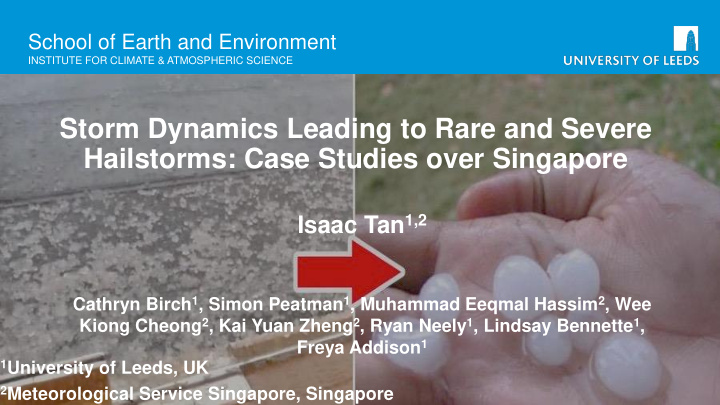



School of Earth and Environment INSTITUTE FOR CLIMATE & ATMOSPHERIC SCIENCE Storm Dynamics Leading to Rare and Severe Hailstorms: Case Studies over Singapore Isaac Tan 1,2 Cathryn Birch 1 , Simon Peatman 1 , Muhammad Eeqmal Hassim 2 , Wee Kiong Cheong 2 , Kai Yuan Zheng 2 , Ryan Neely 1 , Lindsay Bennette 1 , Freya Addison 1 1 University of Leeds, UK 2 Meteorological Service Singapore, Singapore
Outline • Formation of hail and rarity of hail occurrences over Singapore • Study aims and methods • Pre-convective environmental profiles • Further analysis of in-situ and remote sensing observations • Summary
How is hail formed? • Hail growth via the accretion of supercooled liquid water droplets in intense thunderstorms (Ahrens and Henson, 2016). • Violent updrafts carry graupel particles aloft well above the freezing level, which collide with supercooled droplets and grow at their expense (Kumar, 2017). • Tilted updrafts promote lateral growth of graupel – more time above freezing level. Simple hail schematic (Ahrens and Henson, 2016, Fig. 7.31) • Dry mid-level tropospheric layer reduces hail melt as it falls.
The rarity of hail over Singapore • Frequency of hail decreases seaward, poleward, and Singapore equatorward (Lemons, 1942). • Singapore is a small island surrounded by sea – generally unfavourable for hail formation. • Tropical regions characterised by warmer and thicker atmosphere – higher freezing level (MSS 2018b). • Only 6 cases of hail reported at the surface between 2008-2018. • Almost no literature that specifically investigates hail Estimated severe hail global climatology (Cecil occurrences over Singapore and the wider Maritime and Blankenship, 2012, Fig. 7a) Continent region.
Aims of study • To understand the dynamical and microphysical processes that might have resulted in rare hail occurrences over Singapore: ➢ Favourable synoptic conditions for hailstorms in tropical Southeast Asia. ➢ Analysis of ground-based remote sensing and in-situ observations • Is it possible to forecast hailstorm events in this region?
Data and methods • ERA-Interim reanalysis data (1979-2018) and University of Wyoming Skew-T soundings – pre-convective environment (all 6 hail cases). • Ground-based weather station data – surface observations during hail days. • Weather radar – S-band, Doppler, and Dual-polarisation to identify the hail core based on a variety of parameters. • Wind profiler radar – vertical profile of winds from the surface to ~650 hPa. • Lightning detection sensors – to investigate the spatial lightning density
Study area Ground-based weather station data taken from several sites in each of the 5 sectors of Singapore for 2 detailed case studies on 25 June 2013 and 30 January 2018 Changi Climate Station Weather radar and wind profiling data from the Changi Climate Station over eastern Singapore. Four lightning detection sensors over the northern, southern, eastern, and western regions.
Pre-convective environmental profiles • Mid-level dry intrusions – negative relative humidity (RH) anomalies as the key ingredient for hail to reach the surface.
Pre-convective environmental profiles (2) • Dry intrusions are observed at mid-levels in vertical profiles of RH (ERA-Interim).
Pre-convective environmental profiles (3) • Vertical wind shear in the zonal direction is also seen as a favourable indicator for hail reaching the surface.
Pre-convective environmental profiles (4) • Conditional instability is sufficient for the formation of severe thunderstorms
Ground-based weather station data 1-minute resolution ground-based weather station data was only available for the 30 January 2018 case
Changi weather radar plots – useful radar parameters
Lightning strikes density vs. radar reflectivity
Summary of findings • Pre-convective environment characteristics: - Conditional instability (moderate-high CAPE, weak-moderate CIN), - Vertical wind shear - Dry mid-tropospheric intrusions. • Weather station data: - Intense rainfall rates - Strong winds – strong downdrafts and cold pool outflows - Sharp decreases in dry-bulb temperature • Weather radar data – combining radar reflectivity with: - Differential reflectivity - Specific differential phase - Radial velocity • Clear correlation between the hail core and lightning strikes density
Thank you ee15i2t@leeds.ac.uk
Recommend
More recommend